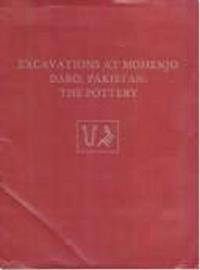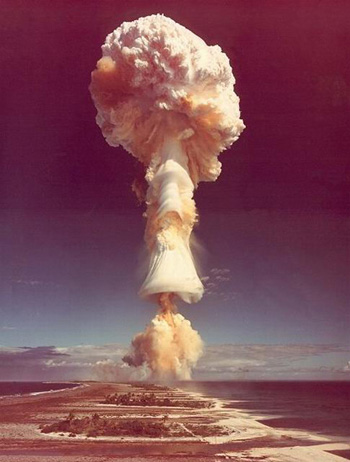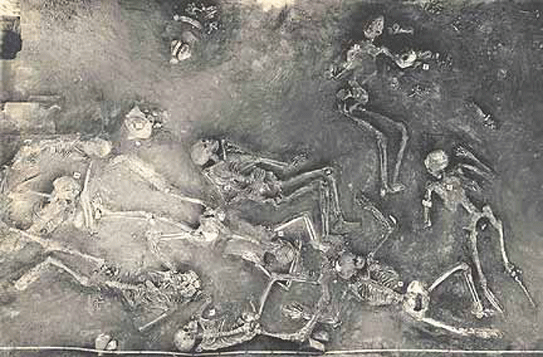|
|
||
|
Pakistan ..
Some have suggested ancient technology glassified these Indus Valley ruins but electricity is a more plausible explanation. From Thunderbolts - Mar 21, 2008 Mesopotamia and the Fertile Crescent region are thought to be the “birthplace” of civilization and the central focus for human culture dating back to the beginning of recorded history. No one knows for sure just how old the generalized composite that we call “society” really is – both because of archeological deficiencies and because of radiometric disconformity – but one of the oldest sites is located in the Indus Valley of Pakistan and appears to date from around 3000-2500 BCE. There are many ways to date ancient artifacts and there are just as many ways to interpret the results from those techniques. It is not the purpose of this paper to address the difficulties inherent with using carbon 14, tree-rings, stratiographic distribution, or any other methodology when attempting to place artifacts or habitations within a chronological sequence. Other articles have addressed those issues, as well as previous Picture of the Day discussions about radioactive decay rates and how external, ionizing sources can change isotope ratios. There is one intriguing aspect to Mohenjo-Daro that sets it apart from most ancient ruins. It is the one anomaly among several at the site that has caused some researchers to suggest that there might have been forces unleashed in the past that are comparable to modern weapons. Walls, pottery and other items found in the city have been turned into a kind of ceramic glass, indicating that they were exposed to heat close to 1500 degrees Celsius. Evidence of ionizing radiation has also been found in some of the burial sites. The oldest myths of the Hindu religion, itself one of the oldest religions in the world, speak of gods flying in vehicles composed of dazzling light and intricately carved platforms called vimanas, that waged war with one another using energy beams of incredible power. In the Hindu religious text known as the Mahabharata, there is a description of one such vehicle: “Gurkha flying in his swift and powerful Vimana hurled against the three cities of the Vrishis and Andhakas a single projectile charged with all the power of the Universe. An incandescent column of smoke and fire, as brilliant as ten thousands suns, rose in all its splendor. It was the unknown weapon, the Iron Thunderbolt, a gigantic messenger of death which reduced to ashes the entire race of the Vrishnis and Andhakas.” Many speculations have been forthcoming about what the vimanas were or what the Iron Thunderbolt might have been. Some of the more imaginative examples see UFO’s and alien spacecraft waging war against the backdrop of primitive humanity, leaving behind a mythological image of gods and demons in conflict. Since the old races were unable to comprehend the idea of technologies on such a vast scale, the only alternative was to invest the phenomena that they observed with divine power. Rather than presupposing a visitation from a super race of extraterrestrials, it is more probable that natural events – although orders of magnitude beyond what we experience today – imprinted themselves on the psyches of our ancestors and inspired the reports of gods in the sky. Several past Pictures of the Day dealt with gigantic geological formations all over the world and with craters exceeding 100 kilometers in diameter. In some cases, the craters are associated with glass spherules or large chunks of pure silica lying in broken pieces all over the desert floor. The fact that the Egyptians considered the “desert glass” from the Great Sand Sea to be sacred and used it to adorn their religious icons is significant because the vitrified walls of Mohenjo-Daro are also said to originate in the wars of the gods, or theomachia. What could account for fields of broken glass shards like those in Egypt, large sheets of glass like “Darwin glass” from Australia, vitrified stone walls in Scotland and the fused pottery and melted ramparts of Mohenjo-Daro? In all these cases, it was probably gigantic plasma discharges in the form of lightning bolts and electric arcs that melted the ruins and fused the soils into glass. The timeframe is probably impossible to determine with any accuracy at this late date, but it seems evident that humanity had reached a high level of sophistication before being exposed to these cataclysmic events. By Stephen Smith |
||
Related Links:
Excavations at Mohenjo Daro, Pakistan: The Pottery, With an Account of the Pottery from the 1950 Excavations of Sir Mortimer Wheeler (University Museum Monograph) by George Dales and Jonathan Mark Kenoyer (Jan 1, 1986) |
||
|
Are the Indian remains of Mohenjo Daro and Harappa, their sudden abandonment and the apparent discovery of an ancient site with a layer of radioactive ash the best available evidence for the possibility that our ancient ancestors possessed a highly advanced technology – which might have included atomic warfare? Philip Coppens
Excerpt: Another candidate for a nuclear explosion, so far left untouched by most of the “ancient astronaut proponents”, is the Indus River Valley, where towns such as Harappa and Mohenjo Daro flourished in 3000 BC, but were then quickly abandoned. One answer that has been put forward is that the ancient cities might have been irradiated by an atomic blast. If true, it would be impossible to ignore the conclusion that ancient civilisation possessed high technology. The ruins of Harappa What this candidate has in its favour is that a layer of radioactive ash was indeed found in Rajasthan, India. It covered a three-square mile area, ten miles west of Jodhpur. The research occurred after a very high rate of birth defects and cancer was discovered in the area. The levels of radiation registered so high on investigators’ gauges that the Indian government cordoned off the region. Scientists then apparently unearthed an ancient city where they found evidence of an atomic blast dating back thousands of years: from 8,000 to 12,000 years. The blast was said to have destroyed most of the buildings and probably a half-million people. So far, this story seems to have all the necessary credentials. Archaeologist Francis Taylor stated
that etchings in
some nearby temples he translated, suggested that
they prayed to be spared
from the great light that was coming to lay ruin to
the city. “It’s
so mind-boggling to imagine that some civilization
had nuclear technology
before we did. The radioactive ash adds credibility
to the ancient Indian
records that describe atomic warfare.”
Another curious sign of an ancient nuclear war in India is a giant crater near Mumbai (formerly Bombay). The nearly circular 2,154-metre-diameter Lonar crater, located 400 kilometres northeast of Mumbai and dated at less than 50,000 years old, could be related to nuclear warfare of antiquity. No trace of any meteoric material, etc., has been found at the site or in the vicinity, and this is the world’s only known “impact” crater in basalt. Indications of great shock (from a pressure exceeding 600,000 atmospheres) and intense, abrupt heat (indicated by basalt glass spherules) can be ascertained from the site. |
||
| The Harappan
Civilization
by Tarini J. Carr It wasn't till 1920 that excavations began in earnest at Harappa. John Marshall, then the director of the Archaeological Survey of India, started a new excavation at Harappa. Along with finds from another archaeologist, who was excavating at Mohenjo Daro, Marshall believed that what they had found gave evidence of a new civilization that was older than any they had known. The city had many drinking water wells, and a highly sophisticated system of waste removal. All Harappan houses were equipped with latrines, bathing houses, and sewage drains which emptied into larger mains and eventually deposited the fertile sludge on surrounding agricultural fields. Seals are one of the most commonly found objects in Harappan cities. They are decorated with animal motifs such as elephants, water buffalo, tigers, and most commonly unicorns. Some of these seals are inscribed with figures that are prototypes to later Hindu religious figures, some of which are seen today. In 2001 Kenoyer's excavations unearthed a workshop that manufactured seals and inscribed tablets. This was significant in that combined with the last 16 years of excavations, it provided a new chronology for the development of the Indus script. Previously, the tablets and seals were all grouped together, but now Kenoyer has been able to demonstrate that the various types of seals and tablets emerged at different times. The writing on the seals and tablets might have changed as well through the years. Kenoyer as well as others are trying to conclude when the dates of the script changes were. The revision of this chronology may greatly aid in the decipherment of the script. (12) There has been attempts at deciphering this script, and the results are not widely agreed upon, and its still a point of controversy.
Dhaulavira Signboard Deciphered Script
Another point that might indicate the Harappan's being a Vedic culture is the discovery of fire altars at several Indus sites. Fire rituals and sacrifice were an important part of Vedic religious practices. But what was significant about these alters, is that they were aligned and constructed in the same manner as later discovered altars were. The fire altars were then Vedic in construction indicating that the Harappan's were a Vedic culture. |
||
|
Posted: August 7, 2011 in "An introduction to the theory, Evidences of high technology in Antiquity, India" Mohenjo Daro (lit. Mound of the Dead, Sindhi: موئن جو دڙو, pronounced), situated in the province of Sindh, Pakistan, was one of the largest settlements of the ancient Indus Valley Civilization. Mohenjo Daro was built around 2600 BC and and continued to exist till about 1800 BC. The ruins of the city were discovered in 1922 by Rakhaldas Bandyopadhyay, an officer of the Archaeological Survey of India. He was led to the mound by a Buddhist monk, who believed it to be a stupa. In the 1930s, massive excavations were conducted under the leadership of John Marshall, K. N. Dikshit, Ernest Mackay, and others.
When excavations of Harappa and Mohenjo-Daro reached the street level, they discovered skeletons scattered about the cities, many holding hands and sprawling in the streets as if some instant, horrible doom had taken place. People were just lying, unburied, in the streets of what once happened to be a sprawling metropolis. And these skeletons are thousands of years old, even by traditional archaeological standards. What could cause such a thing? Why did the bodies not decay or get eaten by wild animals? Furthermore, there is no apparent cause of a physically violent death. These skeletons are among the most radioactive ever found, on par with those at Hiroshima and Nagasaki. An ancient, heavily populated city in Pakistan seemed to have been instantly destroyed 2,000 years before Christ by an incredible explosion that could only been caused by an atomic bomb.
At one site, Soviet scholars found a skeleton which had a radioactive level 50 times greater than normal. Other cities have been found in northern India that show indications of explosions of great magnitude. One such city, found between the Ganges and the mountains of Rajmahal, seems to have been subjected to intense heat. Huge masses of walls and foundations of the ancient city are fused together, literally vitrified! And since there is no indication of a volcanic eruption at Mohenjo-Daro or at the other cities, the intense heat to melt clay vessels can only be explained by an atomic blast or some other unknown weapon. The cities were wiped out entirely. The David Davenport Angle to Mohenjo Daro Extinction [Quotes adapted directly from his works] An ancient, heavily populated city in Pakistan was instantly destroyed 2,000 years before Christ by an incredible explosion that could only been caused by an atomic bomb. That’s the mind bogging conclusion of a British researcher, David Davenport, who spent 12 years studying ancient Hindu scripts and evidence at the site where the great city – Mohenjo Daro once stood. What was found at the site of Mohenjo Daro corresponds exactly to Nagasaki, declared Davenport, who published his startling findings in an amazing book, “Atomic Destruction in 2000 B.C.”, Milan, Italy, 1979. There was an epicenter about 50 yards wide where everything was crystallized, fused or melted, he said. Sixty yards from the center the bricks are melted on one side indicating a blast. the horrible, mysterious event of 4,000 years ago that leveled Mohenjo Daro was recorded in an old Hindu manuscript called the Mahabharata, “White hot smoke that was a thousand times brighter than the sun rose in infinite brilliance and reduced the city to ashes, the account reads. Water boiled…horses and war chariots were burned by the thousands.. . the corpses of the fallen were mutilated by the terrible heat so that they no longer looked like human beings…”. The description concludes, “it was a terrible sight to see … never before have we seen such a ghastly weapon”. Based on his study of many ancient manuscripts, Davenport believes that the end of Mohenjo Daro was tied to a state of war between the Aryans and the Dravidian. Aryans controlled regions where space aliens were mining minerals and exploiting other natural resources, he believes. Because it was a Dravidian city, the aliens had agreed to destroy Mohenjo Daro on behalf of the Aryans. The aliens needed the friendship of the Aryan kings so that they could continue their prospecting and research, explained Davenport. The texts tell us that 30,000 inhabitants of the city were given seven days to get out – a clear warning that everything was about to be destroyed. Obviously, some people didn’t heed the warning, because 44 human skeletons were found there in 1927, just a few years after the city was discovered. All the skeletons were flattened to the ground. For example, a father, mother and child were found flattened in the street, face down and still holding hands. Interestingly, the ancient texts refer repeatedly to the Vimanas, or the flying cars, which fly under their own power, he added. Davenport’s intriguing theory has met with intense interest in the scientific community. Nationally known expert William Sturm said, “the melting of bricks at Mohenjo Daro could not have been caused by a normal fire”. Added professor Antonio Castellani, a space engineer in Rome, “it’s possible that what happened at Mohenjo Daro was not a natural phenomenon”. David Davenport, who spent 12 years studying ancient Hindu scripts and evidence at the ancient site of Mohenjo-Daro, declared in 1996 that the city was instantly destroyed around 2,000 BC. The city ruins reveal the explosion’s epicenter which measures 50 yards wide. At that location everything was crystallized, fused or melted. Sixty yards from the center the bricks were melted on one side indicating a blast… the horrible mysterious event of 4000 years ago was recorded in the Mahabharata. How did man 2000 tears before Christ have the the knowledge of not only producing such high degree of heat, but also harness the power of such high temperatures? If Mohanjo Daro was destroyed by a nuclear catastrophe, who designed and manufactured them? If not then what was used to produce such heat that vitrified rock and bricks? What could be attributed to the high degree of radioactive traces in the skeletons? How did all of them die, in one instant? Its up to us whether we need answers to these questions or continue to live in a sanitized view of the world, as provided to us by mainstream scholarship. With inputs from: |
||
| FAIR USE NOTICE: This page contains copyrighted material the use of which has not been specifically authorized by the copyright owner. Pegasus Research Consortium distributes this material without profit to those who have expressed a prior interest in receiving the included information for research and educational purposes. We believe this constitutes a fair use of any such copyrighted material as provided for in 17 U.S.C § 107. If you wish to use copyrighted material from this site for purposes of your own that go beyond fair use, you must obtain permission from the copyright owner. | ||
|
|








